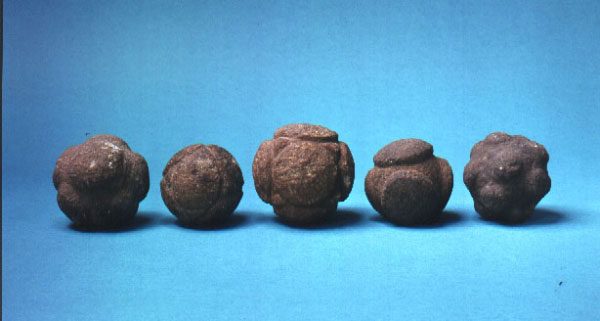Neolithic Carved Stone Polyhedra

Hundreds of carved stone spheres, roughly three inches in diameter, believed to date to around 2000 BC, have been found in Scotland. Some are carved with lines corresponding to the edges of regular polyhedra. Roughly half have 6 knobs---like the one at right above---but the others range from three to 160 knobs. The more mathematically regular ones do not appear to have had a special importance. For example, in addition to the 12-knob dodecahedral form shown in the center and just to its right above, there are also ones with 14 knobs, corresponding to a form with two opposite hexagons, each surrounded by six pentagons. Nonetheless, the dodecahedron appears here long before the Greeks wrote of it. The function of these stones is unknown and so it is unclear whether I should list them here under the category art, but many are intricately carved with spirals or cross-hatching on the faces. The material varies from easily carved sandstone and serpentine to difficult, hard granite and quartzite.
The above image is by Keith Critchlow, scanned from the book by Lawlor. Both those authors lean towards the mystical and must be read critically. In the image, note that the third and fourth balls, with icosahedral and dodecahedral edges indicated, do not correspond to different underlying carvings. I don't know if there are any with exactly 20 knobs arranged as an icosahedron.
For a primary reference (but with
no mathematical
discussion) see Dorothy N. Marshall, "Carved
Stone Balls," Proceedings
of the Society of Antiquaries of Scotland 180, pp. 40-72,
1976/77.
